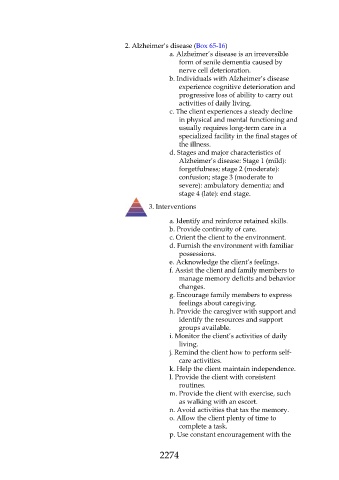Page 2274 - Saunders Comprehensive Review For NCLEX-RN
P. 2274
2. Alzheimer’s disease (Box 65-16)
a. Alzheimer’s disease is an irreversible
form of senile dementia caused by
nerve cell deterioration.
b. Individuals with Alzheimer’s disease
experience cognitive deterioration and
progressive loss of ability to carry out
activities of daily living.
c. The client experiences a steady decline
in physical and mental functioning and
usually requires long-term care in a
specialized facility in the final stages of
the illness.
d. Stages and major characteristics of
Alzheimer’s disease: Stage 1 (mild):
forgetfulness; stage 2 (moderate):
confusion; stage 3 (moderate to
severe): ambulatory dementia; and
stage 4 (late): end stage.
3. Interventions
a. Identify and reinforce retained skills.
b. Provide continuity of care.
c. Orient the client to the environment.
d. Furnish the environment with familiar
possessions.
e. Acknowledge the client’s feelings.
f. Assist the client and family members to
manage memory deficits and behavior
changes.
g. Encourage family members to express
feelings about caregiving.
h. Provide the caregiver with support and
identify the resources and support
groups available.
i. Monitor the client’s activities of daily
living.
j. Remind the client how to perform self-
care activities.
k. Help the client maintain independence.
l. Provide the client with consistent
routines.
m. Provide the client with exercise, such
as walking with an escort.
n. Avoid activities that tax the memory.
o. Allow the client plenty of time to
complete a task.
p. Use constant encouragement with the
2274

